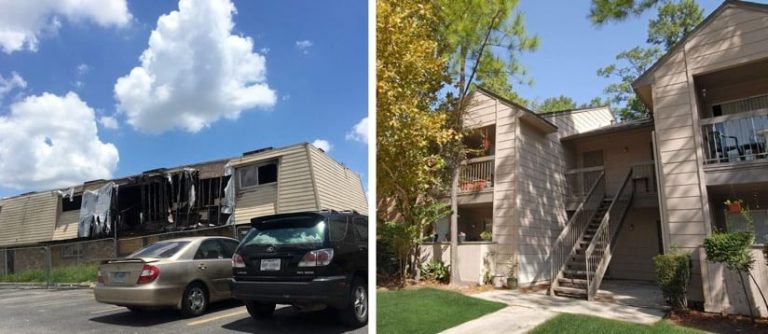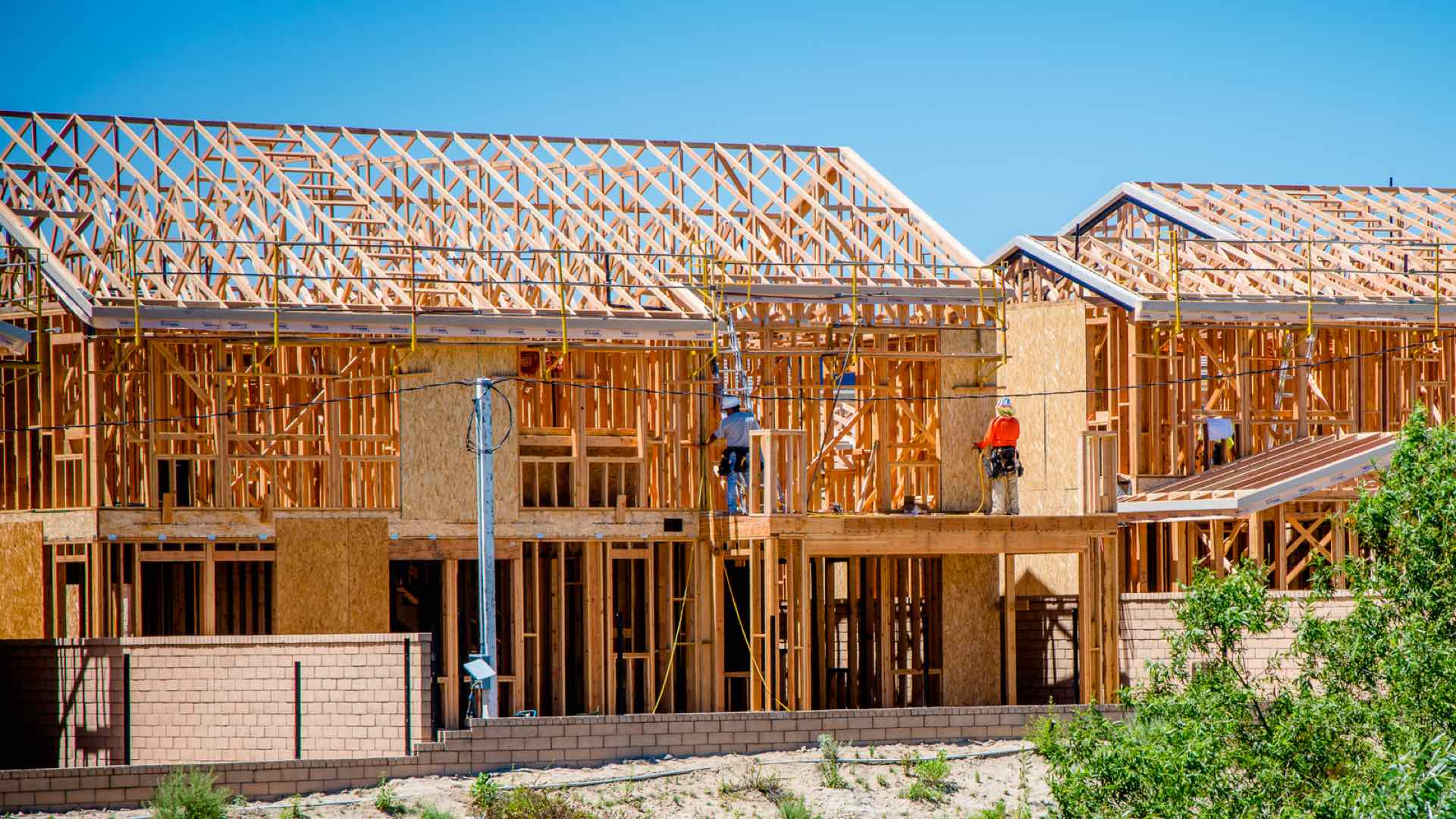

October 22, 2020

As the floodwaters of Hurricane Harvey subsided from Houston, Texas, in 2017, they revealed a troubling pattern: low-income, Black-majority neighborhoods bore the brunt of the destruction.
Houston’s long history of devastating floods devalued the areas in and around floodplains—and due to bygone segregated housing practices, communities of color were established largely on this under-resourced, flood-prone land. Houston remains demographically split along these same geographic lines, with persistent disadvantages affecting quality of housing—and quality of life—for many Black residents.
A recent report offers a visualization of disparities between Houston’s project-based Section 8 apartment complexes in Black-majority versus White-majority neighborhoods. Based on a two-year study published in January 2020 by nonprofit housing advocacy group Texas Housers, the report maps and compares housing conditions and opportunity indicators. The findings align with Houston’s historically divided landscape—and the maps, built with geographic information system (GIS) technology, help clarify the correlation between race, geography, and social inequity.
“Urban policy is often trying to explain concepts to people. Maps provide a clear visual—here is rich, here is poor; here is Black, here is White,” said Mia Loseff, a community equity analyst at Texas Housers.
Loseff and the team at Texas Housers hope the report will give residents an evidence-based resource as they continue to fight for safe, equitable housing.
Stories of Houston residents living with Harvey’s aftermath provide a glimpse into the inequities ingrained in the city’s terrain. Even three years later, devastating details surfaced after Texas Housers’ staff interviewed residents of Houston’s predominantly Black Section 8 apartment complexes. Jamie Wasicek, a resident at Coppertree Apartments, says the mold in her unit has triggered breathing difficulties for her five-year-old son. He occasionally misses school as a result. Daija Jackson, a resident at Arbor Court Apartments, lost everything during Hurricane Harvey—the complex is built directly in a floodway. Jackson was displaced during repairs and returned to find the flood damage barely rectified.

Meanwhile, the team’s photographs from site visits to Section 8 properties in The Woodlands, a northern suburb, paint a different picture. Residents of Copperwood, Holly Creek, Wood Glen, and Fawn Ridge Apartments enjoy amenities like manicured landscaping, units with private balconies, and community pools and playgrounds.
There’s no question that these up close accounts are powerful examples of the report’s findings. But the numbers tell a more sweeping, equally compelling story: in Houston, over 90 percent of low-income renters are Black. In The Woodlands, that number falls to less than 20 percent.
Additionally, about 25 percent of the Houston complexes are located in high-risk floodplains. The Woodlands properties are all in areas with a minimal history of flooding.
Finally, all but one of the complexes located in Houston score in the bottom quarter of nationwide crime indexes—their neighborhoods are rated more dangerous than 75 percent of the country. The Woodlands apartments score in the safest 50 percent.
“The subsidized housing program is supposed to promise opportunity and high quality of life for everyone,” Loseff said. “This particular program does have the potential to work well, but in Houston, it hasn’t for people of color.”
On a map, it’s easy to see why there’s such a stark contrast in residents’ experiences. Houston’s race and wealth maps are nearly identical, with a clear, arrow-shaped patch of White, high-income residents on the east side of downtown. Forty out of Houston’s 43 Section 8 apartment complexes are located outside this area in low-income, Black- and Latinx-majority communities.
Along with income, flood risk, environmental hazards, and crime rate, the report also maps Real Estate Assessment Center physical inspection scores and high school scores. In all categories, the Houston apartments fare worse than their counterparts in The Woodlands.
“These maps tell a clear story,” says Loseff. “They reveal two separate and unequal living experiences, divided across lines of race. You see the history of a nation that has just refused to integrate low-income people into mixed-income locations.”
Lately, as the US contends with entrenched social injustices, the term systemic has become a key component of the equity conversation. Part of the fabric of American society, systemic inequities are a remnant of outdated mindsets and overturned policies that have yet to fully fade into the past. Today, for example, while Americans of color are legally free to pursue the same opportunities as their White contemporaries, socioeconomic adversities faced by their parents and grandparents still frequently limit the ability to afford a college education, secure a high-paying job, or invest in their children’s future.
Housing—and the location of that housing—is a critical turning point in this cycle. “People often look to surrounding census tracts as a predictor of how successful you’ll be,” says Loseff. “The impacts of raising a family in some of these neighborhoods can alter the positive growth trajectory of a child’s life.”
In 2013, for example, economist and Harvard professor Raj Chetty mapped social mobility in the United States, finding that for low-income families, geography had a clear causal effect on a child’s chance at financial betterment. The Texas Housers report corroborates Chetty’s work: even from one low-income family to the next within a 40-mile span from Houston to The Woodlands, location determines access to essential developmental resources like good schools, outdoor activities, and environmental and personal safety.

But, the report also suggests, systemic factors often determine location where people can live, making higher-opportunity areas like The Woodlands all but inaccessible to certain groups. Like many other cities in the US, Houston’s communities of color still reside in the less safe, lesser resourced spaces they were given under eras of segregation, and moving out isn’t always on the table.
The Houston metro area has just 19 affordable and available housing units per 100 low-income people, according to the 2018 The Gap: A Shortage of Affordable Homes Report. And this statistic doesn’t account for the quality of those units. As evidenced by the locations of Houston’s Section 8 complexes, even when residents are able to choose between apartments, it’s often the choice between one under-resourced neighborhood or another. What’s more, with project-based housing, the Section 8 subsidy is tied to properties and landlords, not tenants.
“If a tenant chooses to move [out of these complexes entirely], they will lose their subsidy—the very tool that makes housing affordable to them,” says Loseff.
Inner-city residents also establish support systems among family, friends, and neighbors. “A lot of people are really hesitant to leave an apartment,” says Loseff. “It’s, ‘My gram is down the street, my neighbor can watch my kids.’ That network will tie them there.”
While a safer, affordable home could lie just a half hour away in The Woodlands, changing location can mean starting over with jobs, childcare, and cultural acceptance—costly in both real and social currency.
“We base much of our advocacy on four basic rights for homes and neighborhoods,” says Loseff. The first of these rights is the ability to choose freely where to live in a decent, affordable home. As the report points out, choose is the operative word: until safe housing in high-opportunity areas is a viable option for all low-income renters, there will still be work that needs to be done.
From Homer’s Odyssey to The Wizard of Oz, the concept of home has long been linked to comfort and stability. But approximately 8 percent of Americans receiving Section 8 assistance may lack this sense of safety, based on data from the 2017 American Housing Survey. Respondents categorized their living conditions as severely or moderately inadequate, based on a variety of physical criteria like functional plumbing, visible mold, and pest control.
In Houston specifically, Loseff says, “It creates cumulative disadvantage if you have to live in some of these properties that perform so poorly. We have to recognize this and decide to do better.”
With the release of this report, Texas Housers also called for reforms to protect Houston’s low-income renters. Recommendations include raising standards for Section 8 funding, better enforcement of the Fair Housing Act, building new complexes in higher-opportunity neighborhoods, and including residents in decisions about maintenance and upkeep.
While the first three items rely on policy makers and regulatory bodies, the resources that Texas Housers supplies to low-income Texans can help to give them a stronger voice in the housing conversation right away. Among those resources are GIS maps depicting the current situation.
“For people who live in these underfunded neighborhoods, maps help confirm what they already know and experience,” Loseff said. “They understand that they’re living in an area that’s not as nice as the wealthiest place in town, but with these maps and reports, it’s backed by data.” The goal is to help residents make a stronger case to landlords, council members, or housing authorities, and to empower them to know and fight for their right to a safe home with equal opportunity.
Visit Esri’s Racial Equity GIS Hub to view resources that help organizations address racial inequalities.


